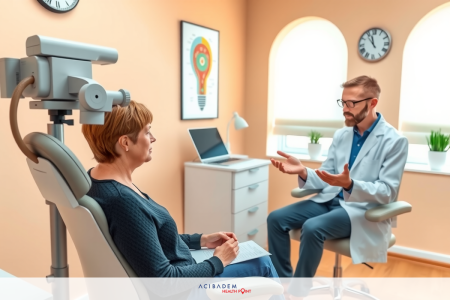Understanding Central Geographic Atrophy Basics
Understanding Central Geographic Atrophy Basics Central geographic atrophy is a retinal disease that gets worse over time. It affects your vision, mainly linked to age-related macular degeneration (AMD). The macula, key for clear central vision, slowly degenerates.
This leads to severe vision loss. Daily tasks become harder and life quality drops for those with it.
It is crucial to know about central geographic atrophy for eye health. The National Eye Institute says it can cause big vision problems. The American Academy of Ophthalmology notes its commonness in older folks, putting a spotlight on it.
Plus, the Acibadem Healthcare Group shows the importance of more research and better treatments. This highlights the need for us to keep learning about and fighting this disease.
What is Central Geographic Atrophy?
Central geographic atrophy is a serious type of macular degeneration. It is known as an advanced type of ‘dry’ AMD. This condition causes parts of the retina to become thin and not work properly. This leads to a big problem with vision in the central area.
Definition and Introduction
Central geographic atrophy targets a specific part of the eye called the macula. The macula gets thinner and loses its cells. This makes it hard to see details in the center of your vision. This condition makes tasks like reading and recognizing faces very difficult.
How It Differs from Other Eye Conditions
This atrophy is not like the ‘wet’ AMD. The ‘wet’ form involves blood vessels that leak and cause scarring. Central geographic atrophy, though, gets worse slowly. It happens as your retinal cells reduce, damaging your retina over time. Knowing these differences helps understand the unique challenges of central geographic atrophy.
Symptoms of Central Geographic Atrophy
Getting central geographic atrophy usually starts subtly. The changes might get bigger over time, causing loss of sight. As a type of macular degeneration, it brings different symptoms that make daily life hard.
You might see dark or blurry areas right in the middle of what you see. This makes reading or knowing faces harder. Colors might look different, making seeing even more complex.
People with this issue often need brighter light for tasks like reading. This need for more light shows how the condition moves slowly.
Here are the main signs of central geographic atrophy:
- Gradual loss of central vision
- Difficulty recognizing faces
- Dark or blurry areas in central vision
- Changes in color perception
- Increased need for brighter light
These signs show a slow breakdown of the macula. This is the part of the eye that’s key for clear vision. Finding it early and getting treatment is important. It helps deal with the problems from this slow eye disease.
Causes of Central Geographic Atrophy
Central geographic atrophy is a serious eye problem. It comes from both genes and the environment. Knowing these reasons helps find people at risk. It also helps plan ways to help them.
Genetic Factors
Genes are very important in getting central geographic atrophy. Studies found genes that make people more likely to have this issue. These genes show that the problem can be handed down in families.
Environmental Factors
What we do and where we live plays a big part in this eye disease. Things like smoking, bad diet, and too much sun can make it worse. Smoking is especially bad because it hurts the back of our eyes. Also, not eating enough good food can make the problem get worse.
| Genetic Factors | Environmental Factors |
|---|---|
| Complement Factor H (CFH) Gene | Smoking |
| ARMS2 Gene | Poor Diet |
| Other Associated Loci | Sun Exposure |
How Central Geographic Atrophy Impacts Vision
Central geographic atrophy makes vision worse over time. It causes a slow loss of vision. This loss can make it hard to do daily things. Knowing how vision loss happens lets people and their helpers deal with it better.
Stages of Vision Loss
The loss of vision from central geographic atrophy happens in stages:
- Early Stage: You might notice it’s hard to see small details. Things might seem a bit blurry.
- Intermediate Stage: Vision gets worse. You may see big spots where you can’t see well. It’s harder to do things like read and drive.
- Advanced Stage: At this point, vision is very bad. Most things in the center of your vision are gone. You might even be legally blind. Recognizing faces and moving around are very hard.
Daily Life Challenges
The disease brings many problems every day. It makes it tough to see and do things like:
- Reading: Seeing small words is hard. You need more light to read.
- Driving: You can’t see the road signs or dangers. This makes driving unsafe for you and others.
- Face Recognition: Telling friends from strangers is hard. This makes socializing and life less fun.
- Daily Tasks: Cooking, handling money, and getting ready become obstacles. You need new ways or tools to do them.
Facing these problems means using special tools and making your home easier to move around in. Vision specialists are there to help. By taking care of your eyes, eating well, and protecting them, you might slow down this disease. This can make life better for those with central geographic atrophy.
| Stage | Characteristics | Impact on Daily Life |
|---|---|---|
| Early | Minor visual changes, slight blurriness | Difficulty in seeing fine details |
| Intermediate | Pronounced vision loss, blind spots | Increased difficulty in reading, driving |
| Advanced | Severe vision impairment, legal blindness | Struggles with face recognition, navigating environment |
By knowing how vision loss happens and the daily struggles, people can learn how to live better. This knowledge helps them manage and improve their life quality even with the disease.
Relationship Between Macular Degeneration and Central Geographic Atrophy
Central geographic atrophy is advanced macular degeneration. It’s the ‘dry’ form. These eye diseases are linked because they both get worse over time. And they can cause serious vision problems.
Macular degeneration starts with drusen, yellow deposits under the retina. Later, in central geographic atrophy, these areas become dead tissue. This affects the macula, which is crucial for good central vision.
Knowing about central geographic atrophy helps in understanding macular degeneration better. This understanding is key to treating and managing the conditions. It’s to help slow down vision loss and make life better for those affected.
| Condition | Stage | Characteristics |
|---|---|---|
| Early Macular Degeneration | Initial | Presence of drusen beneath the retina |
| Intermediate Macular Degeneration | Middle | Increased drusen size and pigment changes |
| Central Geographic Atrophy | Advanced | Extensive retinal degeneration, loss of retinal cells |
Diagnosis of Central Geographic Atrophy
Diagnosing central geographic atrophy needs a full look involving many tests. These tests show the disease extent and place. This leads to the right medical care soon. Ophthalmologists are key here because they know a lot about the eyes. They also use high-tech tools for checking.
Diagnostic Tests
To tell if someone has central geographic atrophy, ophthalmologists use two main things. They look at the person’s health history and take pictures of the eyes:
- Optical Coherence Tomography (OCT): This tool takes detailed pictures of the eye’s back. It shows the different parts and if any are damaged.
- Visual Acuity Tests: They check how well someone sees up close. This can show if the disease is affecting their central vision.
- Fundus Autofluorescence (FAF): A special camera takes pictures of the eye. It looks for areas where the eye’s coloring is missing, which is a sign of the disease.
Role of Ophthalmologists
Ophthalmologists do lots in the central geographic atrophy diagnosis. They:
- Give full eye checks and tests to their patients.
- Read and understand test results from tools like OCT and FAF.
- Tell their patients the exact problem and what to do next, like how to treat it.
Seeing a good ophthalmologist regularly is key in dealing with central geographic atrophy. This helps tailor the care and slow down how fast the disease grows.
Treatment Options for Central Geographic Atrophy
Right now, there isn’t a cure for central geographic atrophy. But, there are ways to slow it down and keep more of your sight. You can use vitamin supplements, change your lifestyle, and try low vision aids. These help based on your own needs.
Scientists are looking into new ways to slow down this eye disease. They’re trying out drugs, working with genes, and using high-tech solutions. The goal is to help keep your sight as good as possible and make life better for you.
Living healthy is key for dealing with this eye problem. People should stop smoking, eat well, and do exercises. This helps your eyes stay healthy. Also, using magnifiers and special lights can make a big difference in your daily life.
| Treatment Strategy | Description | Benefits |
|---|---|---|
| Vitamin Supplements | Includes antioxidants and minerals tailored to ocular health | Supports retinal health and may slow disease progression |
| Lifestyle Modifications | Healthy diet, smoking cessation, regular exercise | Enhances overall health and supports vision preservation |
| Low Vision Aids | Magnifiers, specialized lighting, adaptive devices | Improves daily functioning and quality of life |
| Emerging Therapies | Gene therapy, pharmacological interventions | Potential to halt or significantly slow disease progression |
Managing Eye Health with Central Geographic Atrophy
Proper eye care when you have central geographic atrophy is key. It means getting regular eye exams and using ways to protect your eyes. These help watch how the disease moves and stop more damage.
Regular Eye Exams
Eye check-ups are super important for those with central geographic atrophy. They let doctors keep a close eye on how your eyes are doing. Tests like OCT help spot any changes in your eyes early.
Protective Measures
Using things that protect your eyes is vital for eye health. Sunglasses with UV protection guard your eyes from the sun’s bad rays. Eating foods with omega-3 fatty acids and antioxidants is also good for your eyes.
It’s also smart to cut back on looking at screens too much. And, keeping your blood pressure in check helps prevent more eye damage.
| Protective Measure | Benefit |
|---|---|
| Sunglasses with UV protection | Shield eyes from harmful UV rays |
| Omega-3 fatty acid supplements | Support overall eye health |
| Antioxidant-rich diet | Reduce oxidative stress on the retina |
| Regular physical activity | Improve cardiovascular health, benefiting eye health |
| Reducing screen time | Decrease eye strain |
| Managing blood pressure | Prevent additional damage to the retina |
So, by looking after your eyes and having check-ups, you can better manage your eye health. This is great for living well with central geographic atrophy.
The Role of the Retina in Vision
The retina is crucial for our eyes. It helps us see clearly by turning light into messages for the brain. With its help, we can understand the world around us.
The retina has many layers, each doing a special job. Rods and cones see light and color. The macula helps us see the fine details in the center.
| Aspect | Importance |
|---|---|
| Photoreceptors | Detect light and color |
| Macula | Enables detailed central vision |
| Neural Signals | Transmit visual information to the brain |
Certain diseases harm our sight, like central geographic atrophy. It makes the macula worse, hurting what we see in the middle. Knowing how the retina works makes us see why eye diseases are so serious.
Learning about the retina shows us how vision works. It also tells us how important eye health is. By taking care of the retina and treating problems early, we can keep our vision good. This ifo can help improve our life.
Educational Resources on Retinal Disease
Getting info on retinal diseases like central geographic atrophy is key. It helps patients and families know how to deal with it well. Many groups give out trustworthy info and help.
The American Society of Retina Specialists has lots of info on eye diseases. They share new info, ways to treat diseases, and tips for handling them.
Retina Global is also great for learning how to keep your eye health good. They make info for people to get what retinal diseases do and why finding them early is important.
Retina Today is good for really in-depth articles and advice from experts. They talk about the newest ways to manage retinal diseases. It’s helpful for people and health workers.
Looking into these resources can really help people with eye diseases like central geographic atrophy. Being informed and part of a support group makes handling the disease better.
FAQ
What is central geographic atrophy?
Central geographic atrophy is a type of eye disease. It causes a big loss of vision over time. This disease is linked with age-related macular degeneration (AMD). It affects the macula, which is in the center of the eye, making sharp vision hard.
How does central geographic atrophy differ from other eye conditions?
Central geographic atrophy is a late-stage 'dry' AMD. In this case, the retina gets thin and stops working. Unlike 'wet' AMD, it doesn't involve weird blood vessel growth. So, it's different in how it develops and its effects on the eye.
What are the symptoms of central geographic atrophy?
Symptoms include losing central vision slowly. It gets hard to read or see faces. You might need more light to do things. You might see dark or blurry spots and have trouble seeing colors right.













